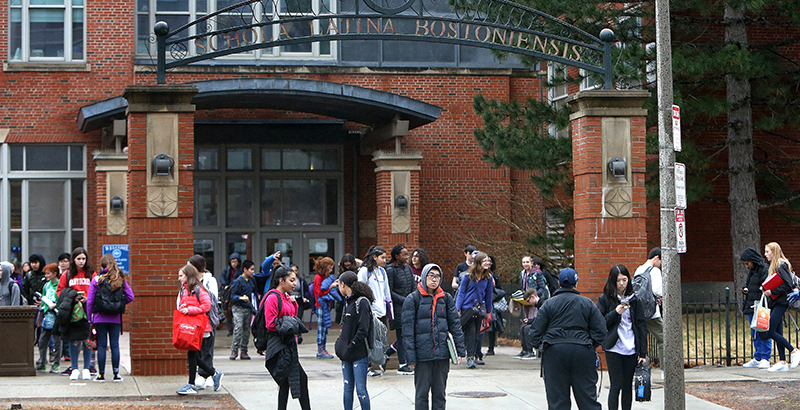Domanico: Coronavirus School Closures Will Cause Irreparable Damage to Students, Schools. How Policymakers Can and Must Soften the Blow

The large-scale closing of schools to protect against the spread of COVID-19 will have a vast negative impact on students and schools.
One hopes that these closures, part of a widespread effort to implement “social distancing,” will yield the intended effect of slowing the spread of the virus. But nothing comes without a cost, and students will bear many of those here. As our political and educational leaders move beyond the immediate public health needs, they will have to deal with the short- and long-term consequences of these closures.
Implementation and effects of virtual learning
In the short term, bullish expectations about the value of remote learning need to be tempered. While things will go fine in some schools and families, others will face major hurdles.
Schools that have been using iPads and laptops in lieu of print books for years will be best suited to weather the current challenge without much disruption to learning. Their students already have the technology at their fingertips, their schools have the necessary software in place, and their teachers are well versed in the use of these tools.
But the schools that are trying to ramp up remote learning quickly in the midst of this crisis are unlikely to see smooth sailing. Equipment will have to be distributed to students who lack it; teachers will need to upload lessons and assignments to new systems; and those systems will have to undergo quality control while they are being used.
What about behavior? Proper supervision for children will be in short supply, particularly where parents are employed in health care or the uniformed services. Many parents in lower-wage jobs will also not be able to stay or work from home, to the extent that they have not been furloughed and facing even greater economic challenges. This will create immense challenges for younger students, who often need supervision and guidance to remain on task. Students of high school age, by contrast, are the most likely to adapt to remote learning — but in many families, these students may be tasked with child care responsibilities for younger siblings.
For students with certain special needs, the challenges will be even greater. Some of these youngsters have been assigned a “one to one” paraprofessional in school to assist them through the day. Unless a parent can assume that role at home, academic learning and behavioral development will surely suffer.
Impact on student assessment
These issues will have implications for student assessment, impediments which will in turn pose challenges for other processes, such as the process of applying to academically screened middle and high schools, and the transition from high school to college or the workforce.
All states administer annual assessments, typically in the spring. The U.S. Department of Education has waived the requirement for annual testing for this year, and many states will cancel these exams. The state of New York has already done so.
Effects on student graduation
For high school seniors in states that use exit or other proficiency exams in their graduation requirements, the cancellations pose obvious challenges. Many high-achieving students will have already fulfilled those requirements prior to the spring of senior year, but in almost every high school, the guidance office has a list of seniors who still need to pass one or two exams by June.
Under normal circumstances, these students would be entering “cram time” to prep for those exams. Cramming is something that can be done from home, assuming students have the technology and the discipline to tackle it, but nonetheless, one can expect to hear calls for some type of waiver of the graduation requirements in the face of lengthy closures. And in districts that use annual test scores for admission to selective programs and schools, the impact will likely be felt next year, when the schools are selecting students for the 2021-22 school year using test results from this year.
It’s time for flexible policy and adaptation to a new era
Policymakers will need to do some soul-searching as they consider these far-reaching effects. Most importantly, they need to accept the consequences of adopting these drastic measures, as necessary as they may have been. When the crisis passes, there is no switch that can be thrown to restore normalcy.
This school year is abnormal — that will never change. The sooner we can come to terms with this reality, the sooner we can meet its challenges. For our leaders, this will mean being flexible and implementing changes to standard procedures for this year, at least.
When this school year passes, schools will be faced with new expectations and demands. Every crisis leads to demands for more services, more resources and other changes to public policy. In response to this crisis, we can expect to see calls for greater preparedness for future pandemics and disruptions. Universal access to technology and equipment will certainly be in high demand, as will investment in online learning software and systems. Teachers will need to be trained in these new modalities as well.
The challenge with fulfilling these demands is that we don’t yet know the magnitude of the economic losses our nation will incur as a result of the ongoing slowdown in large sectors of the economy. It is likely that public resources will be limited at all levels of government, and education will be competing with health care, medical research and other essential services for scarcer resources. Our leaders have delivered a message that there are things more important than schooling and achievement. This is undoubtedly true, but they will soon need to deal with the implications for students, parents and teachers for the foreseeable future.
Ray Domanico is a senior fellow and director of education policy at the Manhattan Institute. He is the author of the new report “A Statistical Profile of New York’s K-12 Educational Sector: Race, Income and Religion.”
Get stories like these delivered straight to your inbox. Sign up for The 74 Newsletter

;)
